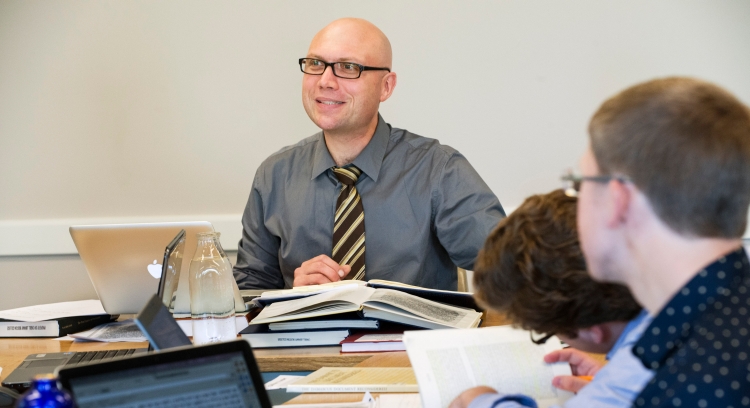
By
Since their discovery in the 1940s, the Dead Sea Scrolls — the earliest known Biblical texts — have fascinated scholars and the faithful alike. Associate Professor of Theology Yonder Moynihan Gillihan, whose teaching and research focus on the Dead Sea Scrolls, is excited about the educational opportunity that the current exhibition at the Museum of Science “Dead Sea Scrolls: Life in Ancient Times” offers students as well as the general public. The exhibition showcases original fragments of the Dead Sea Scrolls, some never before displayed in North America. Gillihan and Associate Professor of Theology David Vanderhooft will present a lecture on the Dead Sea Scrolls to the campus community on Oct. 17 at 6 p.m. in Higgins 310. Gillihan spoke with the Chronicle’s Kathleen Sullivan about the theological and educational significance of the Dead Sea Scrolls.
Q. The Dead Sea Scrolls have been described as the greatest archaeological find of the 20th century. What are some of the more significant aspects of the Dead Sea Scrolls?
The importance of the scrolls for understanding the Bible, early Judaism, and Christian origins can’t be underestimated. The scrolls were copied and used between the second century BCE and the first century CE, a formative period for Christianity and rabbinic Judaism. The text of some biblical scrolls solved longstanding puzzles about what certain passages mean, and these discoveries have changed not only how scholars interpret the Bible, but the very words of the Bible that modern Jews and Christians now read. When the scrolls were discovered it was a mess of 15,000 fragments from 900 manuscripts found in 11 desert caves. The fact that this mess survived at all is amazing; it is almost equally incredible that scholars have been able to reconstruct a fairly coherent “library” out of it.
We've also improved our understanding of what "Scripture" meant in the early synagogues and churches, and how it was interpreted. Besides the books that are now in the Jewish Tanakh and Christian Old Testament, the Dead Sea Scrolls sect studied prophetic books of Enoch, testaments ascribed to various biblical figures, and visionary texts describing a new Jerusalem, a glorious perfected temple, and the final war between the forces of good and evil at the End of Days. Similar such texts and themes appear in the New Testament. We now understand much better what these meant to their first audiences—not to mention what the teachings and deeds of John the Baptist and Jesus would have signified, and why they had appeal. We can also identify distinctive approaches to scriptural interpretation, liturgy, and beliefs in the nature (and number!) of the Messiah that developed in the early synagogues and churches in the first centuries of the Common Era. This illuminates differences that led to the so-called "parting of the ways" between Judaism and Christianity—and how much more complex and lengthy this process was.
Q. What is the importance of the Dead Sea Scrolls to Christians? To Jews?
The Dead Sea Scrolls tell all of us a lot about where we came from, and the depth of our shared heritage. Specific texts do this well, such as the Isaiah scroll: it’s magnificent to behold and 1,000 years older than any other complete manuscript of Isaiah. Christians are moved by the fact that it was used in the time of Jesus, and imagine the scene in Luke where he reads from an Isaiah scroll that must have been very much like this one. But the Dead Sea Scrolls also remind us that Jesus read from that scroll in the synagogue at Nazareth -- he was doing what faithful Jews did, contributing to a conversation about the interpretation of Scripture in the presence of other faithful Jews.
Q. How are you incorporating the Dead Sea Scrolls exhibition into academic life here at BC?
This past weekend I took a group of faculty and students on a tour of the exhibit. On Monday, I’ll take students from my graduate seminar [Hebrew Exegesis of the Dead Sea Scrolls] and my Early Christianity in its Jewish Context class to see the exhibition. On Oct. 19, in cooperation with the Academic Advising Center, I’ll lead a student tour group. On Oct. 17, my colleague David Vanderhooft and I will offer a public lecture, “The Dead Sea Scrolls: Discovery, Scandal, Mysteries,” aimed at anyone curious about this great discovery. We’ll cover all the sensational, juicy nuggets people have heard, along with the most important things that responsible scholars have learned, and some of the mysteries that remain unsolved.
For more on the Museum of Science exhibition, see http://www.mos.org/exhibits/dead-sea-scrolls



